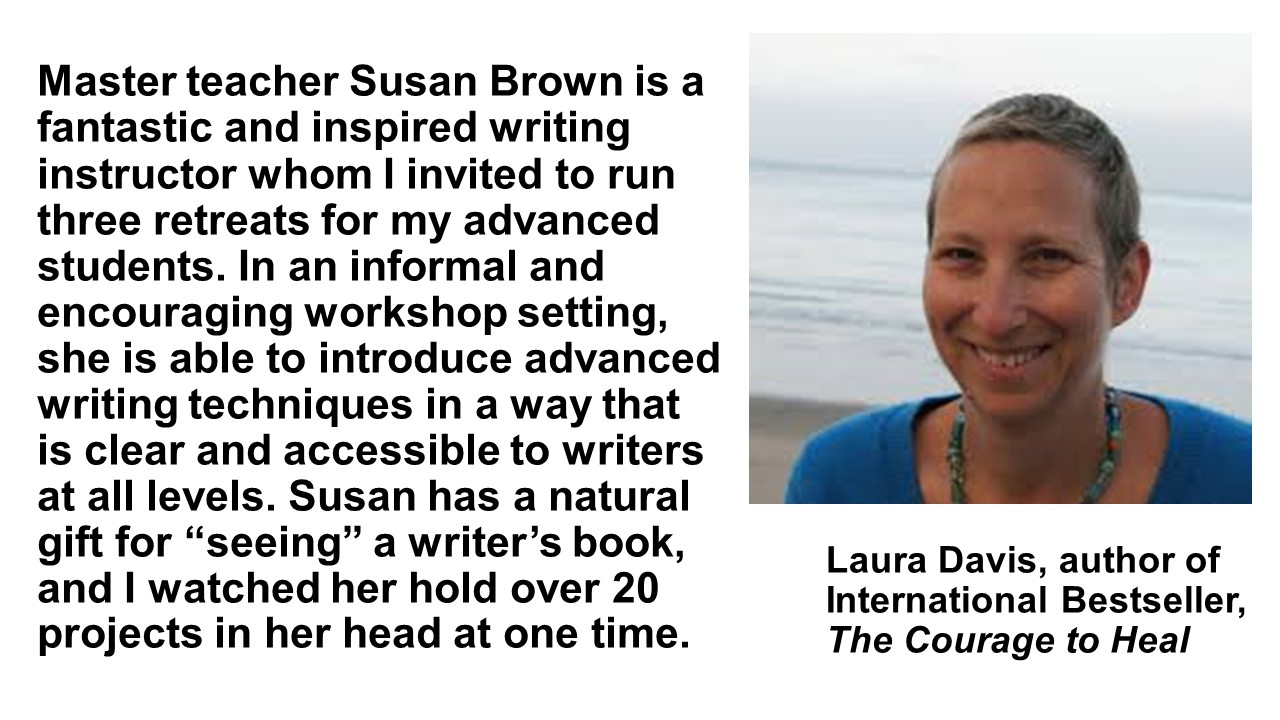Bring Your Writing to the Next Level with the Secret Handshakes of the Greatest Writers
Susan Brown, PhD Seattle, WA Aug. 24-27
contact Leticia Lopez at lopez@serv.net
In this market, your memoir and novel have to read like the classics.
Do you want to give your memoir or fiction more depth and texture? Just as a painter learns palette knife technique sitting at the feet of Wheat Field with Cypresses in the Van Gogh Museum in Amsterdam, writers of all types of narrative—fiction and memoir–can advance their craft by emulating Western culture’s greatest authors. In a four-day intensive workshop, begin or accelerate a writing project by studying and applying the literary secrets from the canon.
As a person who has successfully completed an MFA in Fiction, I have never received such useful instruction and feedback on my work. –Robin Somers, fiction writer
Basing my strategies on 35 years experience as a college creative writing professor, personal book editor, and James Joyce scholar, I work with writers to clarify, improve, or find the theme, voice, structure, and narrative arc for a manuscript in any stage of development. Whatever the genre, length, or subject matter of your project, you will leave the workshop with a clear plan to continue your memoir or novel and enhanced skills to accomplish this.
I encourage writers to raise the bar on their own writing by studying and applying narrative skills such as:
-
How to create a literary—as opposed to simply commercial—narrative (for memoir or fiction) by developing two interdependent plots, external and internal.
-
How to create a charismatic point of view character whose complexity and quest keeps readers turning the page.
-
How to build a dramatic scene in logical steps and layers using literary criteria.
-
How to access a charismatic and accessible narrative voice–witty, metaphysically perceptive, trustworthy, self-examining, verbally original, honest, and fearless.
-
How to craft relevant and engaging three-part dialogue which forwards both external and internal plots and illustrates the theme
-
How to create magical imagery which brings the reader—and writer—inside a setting.
-
How to unify a writing project with narrative threads and a recurring leitmotif.
-
How to construct compelling and dramatic structure for a novel, short story, personal essay, or full-length memoir using efficient drafting techniques (save months, even years)
-
How to achieve a seamless sophisticated style (that reads like butter) using efficient techniques to edit and polish (in layers)
-
How to access the most meaningful, complex, and original themes beating at the heart of your project.
“This was by a landslide the most powerful infusion of both inspiration and solid craft I’ve ever experienced.” —Kat Lancaster, writing a novel
This is the most I have ever learned about the craft of writing in the shortest amount of time.” –Barbara Levitt, writing a memoir and a non-fiction book
We’ll be learning these skills and many other high end techniques from authors such as Charles Dickens, James Joyce, Daniel Woodrell, Ernest Hemingway, Colm Tóibín, Gustave Flaubert, F. Scott Fitzgerald, Toni Morrison, Mark Twain, Leo Tolstoy, Colum McCann, Hunter S. Thompson, Dennis Lehane, Louise Erdrich, and Jeanette Walls. And that’s just to name just a few.
Go! If you want to put your book on an express train to better writing—Go! If you want your story to be read by people and enjoyed—Go! If you want to get at the heart of your material—Go! If you think you’re good and know you can be better, but don’t know how—Go! If you’re ready to think beyond the perfectly crafted scene and build a book that people other than those who love you will want to read—Go! You deserve it and the world needs to hear your story.” –Cathy Krizik, writing a memoir
contact Leticia Lopez at lopez@serv.net





